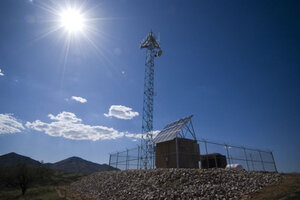Janet Napolitano halts funding for virtual border fence
The virtual border fence was supposed to revolutionize US-Mexico border security. But delays and glitches led Homeland Security Secretary Janet Napolitano to freeze its funding Wednesday.

This undated picture provided by the US Customs and Border Protection shows a prototype of a tower for a virtual fence along the US- Mexico border at a test facility in Playas, N.M.
AP
Los Angeles
In May 2006, President George W. Bush touted the SBInet project as “the most technologically advanced border security initiative in American history.” The proposed "virtual border fence" along the US-Mexican border was to be a string of towers that would use cameras, radar, and ground sensors to see who was coming across in real time.
Now the project, which spent $2.4 billion between 2005 and 2009, has hit so many snags that the Department of Homeland Security (DHS) is freezing its funding.
“Not only do we have an obligation to secure our borders, we have a responsibility to do so in the most cost-effective way possible,” wrote DHS Secretary Janet Napolitano in a press release Tuesday. “The system of sensors and cameras along the Southwest border known as SBInet has been plagued with cost overruns and missed deadlines.”
In early trials, technical problems and other snafus led to media reports that DHS and the Boeing Co., which held contracts to build two sections of the high-tech fence, might mothball the project.
Problems included software glitches, camera images affected by wind and rain, and radar that had trouble distinguishing sagebrush from camping migrants or animals.
Boeing officials admitted that the effort had been more challenging than they anticipated. The project, which was supposed to be handed over to the US Border Patrol in June 2007 was not accepted until December. At a congressional hearing, Richard Stana, Homeland Security and Justice Director for the Government Accountability Office (GAO) said that the first phase of the project "did not fully meet the user needs."
A shift in funding
Now – reportedly two days before the release of a GAO report that was said to criticize the project – Ms. Napolitano says that DHS will shift the funding.
It will redeploy $50 million of Recovery Act funding originally allocated to "commercially available security technology along the Southwest border, including mobile surveillance, thermal imaging devices, ultra-light detection, backscatter units, mobile radios, cameras ,and laptops for pursuit vehicles, and remote video surveillance system enhancements,” Napolitano’s statement said.
Critics of the virtual border fence project have been quick to respond.
“It’s a good thing they have finally acknowledged the obvious, that SBInet is a failure, and they are going to evaluate it,” says T.J. Bonner, president of the National Border Patrol Council, a professional labor union representing more than 17,000 US Border Patrol agents and support staff.
Mr. Bonner thinks that DHS needs to examine the entire premise of using technology at the border.
“We already detect more traffic of illegals than we can apprehend, so we feel the money is better spent putting more boots on the ground than in looking at more technology," he says. "With more personnel cutbacks planned for next year, doesn’t this underline the need to rethink those?”
“DHS could have been more vigilant in oversight," Rep. Bennie Thompson, D-Miss., chair of the House Committee on Homeland Security told NPR Wednesday, "but I can tell you there is no stomach or energy on this committee for this project continuing in its present form.”
Changes at the border
Other experts say that Napolitano’s actions are related to recent incidents at the border.
"Despite evidence of funding constraints at the DHS, Napolitano's actions signal a more deliberate effort by the agency to crack down on illegal immigration at the US-Mexican border in the wake of the shootings that took place in Ciudad Juarez on Saturday, leaving three individuals with ties to the US consulate dead,” says Catherine Wilson, an assistant professor of political science at Villanova University in Pennsylvania, who studies immigration.
On Wednesday, the State Department issued an advisory for US citizens traveling in Tijuana, Nogales, Ciudad Juarez, Nuevo Laredo, Monterrey, and Matamoros, and has authorized the departure of family members of US government personnel in these areas, she notes.
The main question the public should be asking about a virtual border fence is whether the DHS is fully aware of the long-term performance of the security technologies involved, Dr. Wilson and others say.
“Will they, in fact, be more cost-effective than those technologies used in the past?" she asks. "Is this a good use of Recovery Act funding?"
